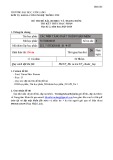NHẬP MÔN LẬP TRÌNH
Contiguous Storage
Arrays, Simple Data Structure Contiguous Storage Searching Sorting
NHẬP MÔN LẬP TRÌNH
Objectives
• How to manage a group of data?
– Store – Input – Output – Search – Sort – …
Contiguous Storage
2
NHẬP MÔN LẬP TRÌNH
Content
• Introduction to contiguous storage • Arrays • One-dimensional Arrays
– Declaration – Memory Allocation – Initialization – Accessing elements – Traversing – 1-D Arrays are parameters of functions – Searching – Sorting • 2-D Arrays
Contiguous Storage
3
NHẬP MÔN LẬP TRÌNH
1- Contiguous Storage
• Commonly, a group of the same meaning elements are
considered.
• They are stored in a contiguous block of memory. • Ex: Group of 10 int numbers 40 bytes block is
needed.
• Data are considered can be a group of some items which
belong to some different data types Contiguous memory block is partitioned into some parts which have different size, one part for an item.
• Data structure: A structure of data stored. • Array is the simplest data structure which contains some
items which belong to the same data type.
• Common used operations on a group: Add, Search,
Remove, Update, Sort
Contiguous Storage
4
NHẬP MÔN LẬP TRÌNH
2- Arrays
0 5
1 4
2 8
3 15
4 90
5 27
6 34
7 21
8 152
9 80
index a (array)
a[i] is an integer
column
a[3] element
m m[1][3]
row
Array: A group of elements which belong to the same data type. Each element is identified by it’s position (index).
• Dimension: Direction that is used to perform an action on array. • Number of dimensions: Number of indexes are used to specify
an element.
• Common arrays: 1-D and 2-D arrays. • Name of an array: An array has it’s name.
Contiguous Storage
5
NHẬP MÔN LẬP TRÌNH
3- One Dimensional (1-D)Arrays
• 1-D array: a collection of items (elements,
terms) which belong to the same data type and are stored contiguously in memory.
Each element is identified by a unique index of it’s position in the array (an integer from 0).
index 0 1 2 3 4 5 6 7 8 9
5 4 8 15 90 27 34 21 152 80
a (array)
Contiguous Storage
6
a[3] element a[i] is an integer
NHẬP MÔN LẬP TRÌNH
1-D Arrays: Declaration
• If the array is stored in the stack segment Use a STATIC array The compiler will determine the array’s storage at compile-time.
• If the array is stored in the heap Use a pointer
(DYNAMIC array) The array’s storage will be allocated in the heap at run-time through memory allocating functions (malloc, calloc, realloc)
DataType ArrayName[NumberOfElements] ;
How compilers can determine the memory size of an array? NumberOfElements * sizeof(dataType) int a1[5] 5 *sizeof(int) = 5*4 = 20 bytes Examples: int a1[5]; char s[12]; double a3[100];
Contiguous Storage
7
float *a; a = (float*)calloc (10, sizeof(float)); /* allocate a block of 10 float numbers */
NHẬP MÔN LẬP TRÌNH
1-D Arrays: Memory Allocation
4202496
Data segment
code
4199056
Code segment
20
The name of the array is the address of the first element.
Heap
4072496
Stack segment
80 bytes
a1: 2293584 a2:2293580
Contiguous Storage
8
20 bytes 4072496
NHẬP MÔN LẬP TRÌNH
1-D Arrays: Initialization & Accessing Elements
Initialize an array: Type a[] = {val1, val2, … };
How to access the ith element of the array a? • a is the address of the first element. Based on operation on
pointers: a+i : address of the ith element, another way: &a[i] *(a+i): value of the ith element, another way: a[i]
Contiguous Storage
9
NHẬP MÔN LẬP TRÌNH
1-D Arrays: Init. & Accessing…
Compiler will automatically count number of initial values to determine the size of array memory
The size of array memory is pre- defined. Compiler will fill 0 to elements which are not initialized.
Contiguous Storage
10
int a[5]; Elements contain un-predictable values because they are local variables. TEST IT !!!!
NHẬP MÔN LẬP TRÌNH
1-D Arrays: Traversing
• A way to visit each element of an array • Suppose that the 1-D array, named a, containing n
elements.
• Forward traversal:
int i;
for (i=0; i • Backward traversal: int i;
for (i=n-1; i >=0; i--)
{ [if (condition)] Access a[i];
} Contiguous Storage 11 NHẬP MÔN LẬP TRÌNH • The array parameter of a function is the pointer of the first element of the array. Contiguous Storage 12 NHẬP MÔN LẬP TRÌNH • Develop a C-program that will: -Accept values to an integer array that may contain 100 elements.
- Print out the it’s maximum value.
- Print out it’s elements.
- Print out it’s even values. • Nouns: • Verbs: -Begin
-Input n (one value)
-Input a, n (function)
- maxVal = get maximum value in a, n (function)
- Print out maxVal (one value)
- Print out a, n (function)
- Print even values in a, n (function)
- End – Constant:
MAXN=100
–Static array of integers
int a[MAXN]
–Real number of
elements int n
–Maximum value
int maxVal. Contiguous Storage 13 NHẬP MÔN LẬP TRÌNH Contiguous Storage 14 NHẬP MÔN LẬP TRÌNH Contiguous Storage 15 NHẬP MÔN LẬP TRÌNH • Comments – If you allocate an array having 100 elements but 6 elements are used then memory is wasted.
– If If you allocate an array having 100 elements
but 101 elements are used then there is a lack of
memory. • Solution: Use a dynamic array. Contiguous Storage 16 NHẬP MÔN LẬP TRÌNH replace int* a insert a = (int*) calloc (n, sizeof(int)); Contiguous Storage 17 Other functions are
preserved. NHẬP MÔN LẬP TRÌNH Contiguous Storage 18 NHẬP MÔN LẬP TRÌNH • Develop a C-program that will: -Accept values to an integer array that may
contains 100 elements. The input will terminate
when user enters the value of zero.
- Print out the it’s maximum value.
- Print out it’s elements.
- Print out it’s even values. Contiguous Storage 19 The difference between this problem with the previous one is the input operation can
terminate abruptly when 0 is accepted.
Memory block of the array needs to be allocated in excess
The function for input values of the array must be modified for this case and the
number of elements is updated after each valid value is accepted. NHẬP MÔN LẬP TRÌNH Contiguous Storage 20 NHẬP MÔN LẬP TRÌNH x=3 n=0 1 3 x=7 n=3 4 3 5 2 Contiguous Storage 21 NHẬP MÔN LẬP TRÌNH • A search algorithm finds the record of interest using the key array • Return value: The positional index at
which the interest value is found.
• Two common search algorithms are – linear search
– binary search Contiguous Storage 22 NHẬP MÔN LẬP TRÌNH array a having n elements. 5 9 2 7 6 5 2 5 i=0 1 2 3 4 5 9 2 7 6 5 2 5 i=0 1 2 3 4 5 6 7 for ( i=0; i for ( i=n-1; i>=0; i--) int firstLinearSearch ( int x, int a[], int n)
{ int i; int lastLinearSearch ( double x, double *a, int n)
{ int i; if ( x == a[i] ) return i; if ( x == a[i] ) return i; return -1; return -1; Contiguous Storage 23 } } NHẬP MÔN LẬP TRÌNH Contiguous Storage 24 NHẬP MÔN LẬP TRÌNH int binarySearch ( int x, int a[], int n)
{ int i=0, j= n-1, c ; while (i<=j)
{ c= (i+j)/2; if ( x== a[c] ) return c ;
if (x < a[c] ) j = c-1;
else i = c +1; }
return -1; return c (7) } Contiguous Storage 25 i>j return -1 NHẬP MÔN LẬP TRÌNH n= 2m 1 2m-1 1 No. of elements considered No. of comparisons 2m-2 1 … … 20 1 Contiguous Storage 26 Sum m+1 = log2(n) +1 NHẬP MÔN LẬP TRÌNH • Sorting: Changing positions of elements in an
array so that values are in a order based on a
pre-defined order relation. • Default order relation in set of numbers: Value order • Default order relation in a set of characters/ strings: Dictionary order • Only two sorting algorithms are introduced here.
– Selection Sort
– Bubble Sort Contiguous Storage 27 NHẬP MÔN LẬP TRÌNH •
•
• Find the minimum value in the list
Swap it with the value in the first position
Repeat the steps above for remainder of the list Contiguous Storage 28 NHẬP MÔN LẬP TRÌNH Contiguous Storage 29 NHẬP MÔN LẬP TRÌNH by •It works
repeatedly
stepping
through the list
to be sorted,
comparing two
items at a time
and swapping
them if they are
in the wrong
order. •The
pass
through the list
repeated
is
until no swaps
needed,
are
which means
the list is sorted Contiguous Storage 30 NHẬP MÔN LẬP TRÌNH Contiguous Storage 31 NHẬP MÔN LẬP TRÌNH • Develop a C-program that helps user managing an 1-D
array of integers (maximum of 100 elements) using the
following simple menu: • 1- Add a value
• 2- Search a value
• 3- Remove the first existence of a value
• 4- Remove all existences of a value
• 5- Print out the array
• 6- Print out the array in ascending order (positions of elements are preserved) • 7- Print out the array in descending order (positions of elements are preserved) • Others- Quit Contiguous Storage 32 NHẬP MÔN LẬP TRÌNH • In this program, user can freely add or remove one or more elements to/
from the array. So, an extra memory allocation is needed (100 items). • Data: Array of integers int a[100], n
searched/added/removed number int value • Functions: increase number of elements – int menu() Get user choice
– int isFull(int *a, int n) - Testing whether an array is full or not
– int isEmpty(int *a, int n) - Testing whether an array is empty or not
– void add(int x, int*a, int*pn) adding an element to the array will – int search(int x, int *a, int n) return a position found in the array
– int removeOne (int pos, int*a, int*pn) Removing a value at the position number of elements return 1: successfully, 0: fail pos will decrease number of elements return 1: successfully, 0: fail
– int remove All(int x, int*a, int*pn) Removing a value will decrease Contiguous Storage 33 – void printAsc(int*a, int n) – printing array, elements are preserved
– void printDesc(int*a, int n) – printing array, elements are preserved
– void print(int*a, int n) NHẬP MÔN LẬP TRÌNH After values 0 , 2, 8, 9, 7, 3, 2, 4, 2 are
added. Use menu 5 to view them. Contiguous Storage 34 Search option Remove one option NHẬP MÔN LẬP TRÌNH Print out in ascending order
(elements are preserved) Remove all option Contiguous Storage 35 Print out in descending order
(elements are preserved) NHẬP MÔN LẬP TRÌNH Contiguous Storage 36 NHẬP MÔN LẬP TRÌNH index 0 2 9 7 3 2 4 2 2 9 7 3 2 4 2 2 Contiguous Storage 37 NHẬP MÔN LẬP TRÌNH 2 2 4 0 2 9 7 3 2 2 4 0 2 9 7 3 2 4 0 2 9 7 3 2 4 0 2 9 7 3 2 0 2 9 7 3 4 0 2 9 7 3 4 0 2 9 7 3 4 0 2 9 7 3 4 0 9 7 3 4 0 9 7 4
3
Contiguous Storage 38 NHẬP MÔN LẬP TRÌNH 2293504
2293492
2293488
2293496
2293500 Values of pointers
after sorting 2293504
2293500
2293496
2293492
2293488 4223516 adds 4223516 2293504
2293500
2293496
2293492
2293488 5
1
2
4
3 Contiguous Storage 39 NHẬP MÔN LẬP TRÌNH Contiguous Storage 40 NHẬP MÔN LẬP TRÌNH Contiguous Storage 41 NHẬP MÔN LẬP TRÌNH Contiguous Storage 42 NHẬP MÔN LẬP TRÌNH Contiguous Storage 43 NHẬP MÔN LẬP TRÌNH • A group of elements which belong to the same
data type and they are divided into some rows
and some columns (it is called as matrix also). • Each element is identified by two indexes (index of row, index of column). column row m m[1][3] [if (condition)] Access m[i][j]; The next slide
will
demonstrate
how static
and dynamic
2-D arrays are
stored. } Contiguous Storage 44 NHẬP MÔN LẬP TRÌNH H
E
A
P 4078848
4078840
4078832
4078824
4078808
4078800
4078792
4078784
4078768
4078760
4078752
4078744 4078720 4078824
4078784
4078744 4078616 2293600
2293596 m2
p 4078720
4078616 2293532
2293528
2293524
2293520
2293516
2293512
2293508
2293504
2293500
2293496
2293492
2293488 m1 Contiguous Storage 45 S
T
A
C
K NHẬP MÔN LẬP TRÌNH Keep in your mind the way to
specify a matrix as a parameter
of a function ( the number of
column must be pre-defined.). Contiguous Storage 46 Accept a matrix maximum 20x20.
Print out maximum value in it, print out the matrix. NHẬP MÔN LẬP TRÌNH Contiguous Storage 47 NHẬP MÔN LẬP TRÌNH • Array is the simplest data structure for a group of
elements which belong to the same data type. • Each element in an array is identified by one or more index beginning from 0. • Number of dimensions: Number of indexes are used to identify an element. • Static arrays Stack segment Type a[MAXN];
Type m[MAXROW][MAXCOL]; • Dynamic array: Use pointer and allocate memory using functions
double *a = (double*)calloc(n, sizeof(double));
int** m = (int**) calloc(row, sizeof(int*));
for (i=0; i Contiguous Storage 48 NHẬP MÔN LẬP TRÌNH • Accessing elements in an array: 1-D Array (a) 2-D Array (m) Address Value Address Value a+index *(a+index) &a[index] a[index] &m[i][j] m[i][j] a + index*sizeof(DataType) m + (i*NumCol + j)*sizeof(DataType) • Common operations on • Base of algorithms on
arrays: Traversing Contiguous Storage 49 NHẬP MÔN LẬP TRÌNH • Develop a C-program that helps user managing an 1-
D array of real numbers(maximum of 100 elements)
using the following simple menu: • 1- Add a value
• 2- Search a value
• 3- Print out the array
• 4- Print out values in a range (minVal<=value<=maxVal, minVal and maxVal are
inputted) • 5- Print out the array in ascending order (positions of elements are preserved) • Others- Quit Contiguous Storage 50 NHẬP MÔN LẬP TRÌNH Contiguous Storage 511-D Array is a Function Parameter
• Input an array of n integers
void input (int* a, int n)
• Input elements of an array of integers which it’s
number of element is stored at the pointer pn
void input (int a[], int*pn)
• Output an array of n double numbers
void output (double a[], int n)
• Calculate the sum of an array of n integers
int sum (int *a, int n)
Array Function Parameter: Demo.
Array Function
Parameter: Demo 1.
Array Function Parameter: Demo 1.
Array Function Parameter: Demo 1.
Array Function
Parameter: Demo 1.
Array Function Parameter: Demo 1.
Array Function Parameter: Demo 2.
Array Function Parameter: Demo 2.
Array Function Parameter: Demo 2.
0
0
1
2
1-D Arrays: Searching
1-D Arrays: Searching…
Linear search: Find the position of the value x in the
Search the value of 6 in the array a having 8 items.
Search the value of 12 in the array a having 8 items.
There may be
n comparisons
performed.
-1
1-D Arrays: Linear Searching…
1-D Arrays: Binary Searching…
Binary search
- Condition for
application:
Values in the
array were
sorted.
1-D Arrays: Binary Searching…
Evaluation:
1-D Arrays: Sorting
1-D Arrays: Selection Sort
1-D Arrays: Selection Sort
1-D Arrays: Bubble Sort
1-D Arrays: Bubble Sort…
1-D Arrays: A Sample
1-D Arrays: A Sample…
1-D Arrays: A Sample…
1-D Arrays: A Sample…
1-D Arrays: A Sample…
1-D Arrays: A Sample…
0
1
2
3
4
5
6
7
8
1-D Arrays: A Sample…
8
7
6
0
1
2
3
4
5
1-D Arrays: A Sample…
1-D Arrays: A Sample…
1-D Arrays: A Sample…
1-D Arrays: A Sample…
1-D Arrays: A Sample…
4- Two-Dimensional Arrays
Traversing a matrix:
for ( i =0; i
3- 2-D Arrays: Memory Structure
Static 2-D Arrays Demo.
Static 2-D Arrays Demo.
Summary
Summary
Compiler determines the address of an element:
arrays:
• Add an element
• Search an element
• Remove an element
•
Input
• Output
• Sort
Exercise- Do yourself
Thank You



















![Hệ thống quản lý cửa hàng bán thức ăn nhanh: Bài tập lớn [chuẩn nhất]](https://cdn.tailieu.vn/images/document/thumbnail/2025/20251112/nguyenhuan6724@gmail.com/135x160/54361762936114.jpg)
![Bộ câu hỏi trắc nghiệm Nhập môn Công nghệ phần mềm [mới nhất]](https://cdn.tailieu.vn/images/document/thumbnail/2025/20251111/nguyenhoangkhang07207@gmail.com/135x160/20831762916734.jpg)





